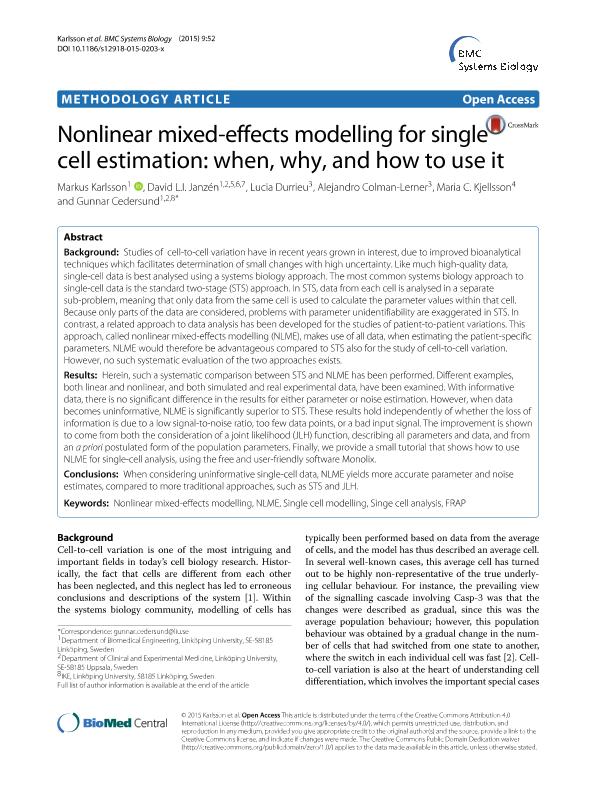Artículo
Nonlinear mixed-effects modelling for single cell estimation: When, why, and how to use it
Karlsson, Markus; Janzén, David L.I.; Durrieu, Lucía ; Colman Lerner, Alejandro Ariel
; Colman Lerner, Alejandro Ariel ; Kjellsson, Maria C.; Cedersund, Gunnar
; Kjellsson, Maria C.; Cedersund, Gunnar
 ; Colman Lerner, Alejandro Ariel
; Colman Lerner, Alejandro Ariel ; Kjellsson, Maria C.; Cedersund, Gunnar
; Kjellsson, Maria C.; Cedersund, Gunnar
Fecha de publicación:
09/2015
Editorial:
BioMed Central
Revista:
Bmc Systems Biology
ISSN:
1752-0509
Idioma:
Inglés
Tipo de recurso:
Artículo publicado
Clasificación temática:
Resumen
Background: Studies of cell-to-cell variation have in recent years grown in interest, due to improved bioanalytical techniques which facilitates determination of small changes with high uncertainty. Like much high-quality data, single-cell data is best analysed using a systems biology approach. The most common systems biology approach to single-cell data is the standard two-stage (STS) approach. In STS, data from each cell is analysed in a separate sub-problem, meaning that only data from the same cell is used to calculate the parameter values within that cell. Because only parts of the data are considered, problems with parameter unidentifiability are exaggerated in STS. In contrast, a related approach to data analysis has been developed for the studies of patient-to-patient variations. This approach, called nonlinear mixed-effects modelling (NLME), makes use of all data, when estimating the patient-specific parameters. NLME would therefore be advantageous compared to STS also for the study of cell-to-cell variation. However, no such systematic evaluation of the two approaches exists. Results: Herein, such a systematic comparison between STS and NLME has been performed. Different examples, both linear and nonlinear, and both simulated and real experimental data, have been examined. With informative data, there is no significant difference in the results for either parameter or noise estimation. However, when data becomes uninformative, NLME is significantly superior to STS. These results hold independently of whether the loss of information is due to a low signal-to-noise ratio, too few data points, or a bad input signal. The improvement is shown to come from both the consideration of a joint likelihood (JLH) function, describing all parameters and data, and from an a priori postulated form of the population parameters. Finally, we provide a small tutorial that shows how to use NLME for single-cell analysis, using the free and user-friendly software Monolix. Conclusions: When considering uninformative single-cell data, NLME yields more accurate parameter and noise estimates, compared to more traditional approaches, such as STS and JLH.
Archivos asociados
Licencia
Identificadores
Colecciones
Articulos(IFIBYNE)
Articulos de INST.DE FISIOL., BIOL.MOLECULAR Y NEUROCIENCIAS
Articulos de INST.DE FISIOL., BIOL.MOLECULAR Y NEUROCIENCIAS
Citación
Karlsson, Markus; Janzén, David L.I.; Durrieu, Lucía; Colman Lerner, Alejandro Ariel; Kjellsson, Maria C.; et al.; Nonlinear mixed-effects modelling for single cell estimation: When, why, and how to use it; BioMed Central; Bmc Systems Biology; 9; 1; 9-2015; 1-15
Compartir
Altmétricas



